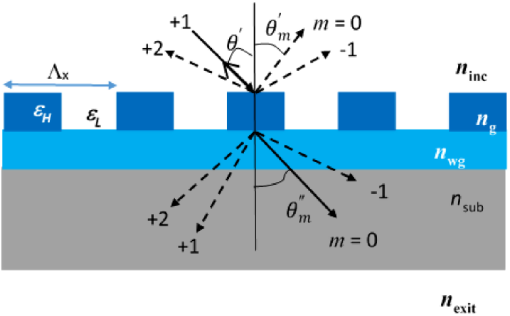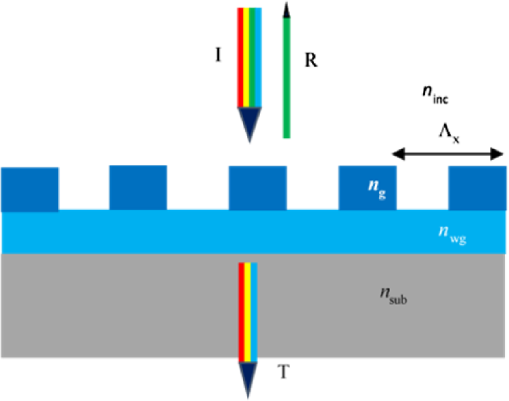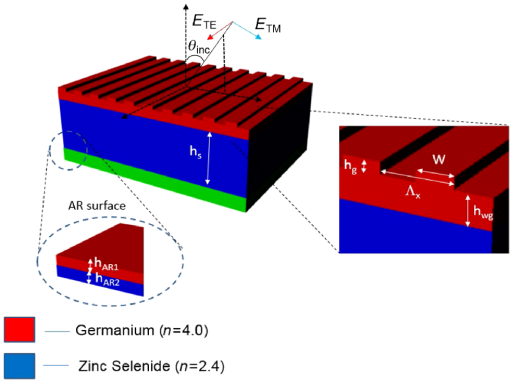使用量子级联激光器的可调谐长波红外陷波滤波器的...-1
使用量子级联激光器的可调谐长波红外陷波滤波器的性能特征
我们描述了在可调谐整个光谱范围内使用量子级联激光器(QCL)在8至12微米的长波红外中操作的可光谱调谐微工程陷波滤波器的设计和性能表征。滤波器的设计基于导模共振现象。器件结构由平面波导顶部的亚波长介电光栅组成,该光栅使用高折射率透明介电材料,即折射率分别为4.0和2.4的锗(Ge)和硒化锌(ZnSe)。滤光片被设计为在一个(或多个)窄光谱带反射入射的宽带光,同时完全透射其余的光。通过使滤光器机械倾斜来改变入射角,可以实现反射波长的光谱调谐。基于一维(1-D)光栅的滤波器与偏振有关,而基于二维(2-D)光栅的滤波器则与偏振无关。施加简单的两层抗反射涂层,以最大程度地减少滤光片基板未图案化一侧的反射。我们的实验装置包括一个在室温下运行的商用QCL系统,一个微工程滤波器和一个未冷却的宽带传感器。我们介绍了滤波器的设计和详细的表征实验,并比较了一维滤波器的理论和实验结果。
Performance characterization of tunable longwave infrared notch filters using quantum cascade lasers
Neelam Gupta; Mark S. Mirotznik
Neelam Gupta,1 Mark S. Mirotznik2
1U.S. Army Research Lab. (United States)
2Univ. of Delaware (United States)
Abstract
We describe the design and performance characterization of spectrally tunable microengineered notch filters operating in the longwave infrared from 8 to 12 micron using quantum cascade lasers (QCLs) tunable over the full spectral range. The filter design is based on the guided mode resonance phenomenon. The device structure consists of a subwavelength dielectric grating on top of a planar waveguide using high-index transparent dielectric materials, i.e., germanium (Ge) and zinc selenide (ZnSe) with refractive indices of 4.0 and 2.4, respectively. The filters are designed to reflect the incident broadband light at one (or more) narrow spectral band while fully transmitting the rest of the light. Spectral tuning of the reflected wavelength is achieved by changing the angle of incidence by mechanically tilting the filter. Filters based on one-dimensional (1-D) gratings are polarization dependent and those based on two-dimensional (2-D) gratings are close to polarization independent. Simple two-layer antireflection coatings were applied to minimize reflections from the nonpatterned side of the filter substrate. Our experimental setup consisted of a commercial QCL system operating at room temperature, a microengineered filter, and an uncooled broadband sensor. We present the filter design and detailed characterization experiment, and compare the theoretical and experimental results for 1-D filters.
1.
Introduction
There is a need to develop compact tunable notch or laserline rejection transmission filters operating in the longwave infrared (LWIR) region. Such a filter will efficiently block a single or multiple discrete narrow wavelength band(s), while transmitting light in the rest of the spectral region. Spectrally tunable filters are used for a wide variety of applications in imaging and sensing. Such tunable filters include acousto-optic tunable filters, liquid-crystal tunable filters, Fabry-Perot filters, and so on that operate over many spectral regions including LWIR. Existing spectral filter technologies, however, are inadequate for notch filtering applications as they transmit only a narrow band of light and reject the rest of the light in the spectral region. While filters that can perform notch filtering operation have been developed within the visible to midwave infrared, they are not available in the LWIR region.
In this paper, we present a microengineered metamaterial tunable notch LWIR filter using transparent dielectric materials, germanium (Ge) and zinc selenide (ZnSe) with refractive indices of 4.0 and 2.4, respectively, based on the guided mode resonance (GMR) phenomenon. The resultant filter with subwavelength features possesses a sharp reflectance peak at a designed resonant wavelength while transmitting rest of the light. The resonant wavelength can be tuned mechanically by simply tilting the device with respect to the optical axis. Filters based on one-dimensional (1-D) gratings are polarization-dependent and those based on two-dimensional (2-D) gratings are close to polarization-independent. We have designed and fabricated prototype notch filters with 1-D gratings and characterized their performance using a room-temperature quantum cascade laser (QCL) system tunable over the full LWIR region from 8 to 12 μm. We present the theoretical background required for modeling and simulation, design of the 1-D filter, the experimental setup, and both the simulation and measurement results and compare them.
2.
Guided Mode Resonant Filters
GMRFs are all dielectric filters that exploit the GMR phenomenon. The GMR effect, shown in Figs. 1 and 2, occurs when a transverse guided mode is excited within a dielectric waveguide by the diffracted light from the grating. The resultant-guided modes slowly leak energy due to the index modulation provided by the grating and waveguide combination that interferes with the incident wave producing a filtering response. The excitation of the leaky guided mode will only occur if certain resonant conditions are satisfied. Specifically, the effective index of refraction of the waveguide, nwg, must satisfy
Eq. (1)
Max[ninc,nsub]≤|ninc sinθinc−mλΛx|<nwg,
where ninc and nsub represent the indices of refraction of the incident region and substrate, respectively, θincdenotes the angle of incidence, λ is the free-space wavelength, m is the diffracted order, and Λx is the grating period. When this condition is satisfied, it is possible to design a waveguide and grating structure that results in a 100% reflectance over a narrow spectral band. Moreover, as the resonant condition is sensitive to both the geometry of the GMRF stack as well as the angle of incidence, it is feasible to design tunable geometries over a broad spectral band by varying these parameters.1–9
Fig. 1Download
GMR grating-waveguide layers with diffractive orders illustrated; ϵH and ϵL represent dielectric permittivities for grating and no-grating regions. The refractive indices for each region are labeled.

Fig. 2Download
GMR grating-waveguide layers on a substrate schematically showing reflection at resonant wavelength and transmission at all other wavelengths due to coupling of one diffracted order in waveguide to excite leaky guided mode.

3.
Basic Filter Configuration
For these devices, we used the filter configuration shown in Fig. 3. Here, the 1-D gratings were fabricated on a Ge waveguide layer deposited on the surface of a thick ZnSe substrate. An antireflective (AR) surface comprising alternating layers of Ge and ZnSe was fabricated on the bottom of the substrate. In the figure, Λx is the grating period, hwg is the thickness of the planar waveguide, hg is the thickness of the grating groove, hsis the thickness of the substrate, hAR1 is the thickness of the Ge layer, and hAR2 is the thickness of the ZnSe layer in the AR coating. A rigorous electromagnetic solver was developed to analyze and design the device shown in Fig. 3.
Fig. 3Download
Basic GMRF configuration for a 1-D device. A grating and a planar waveguide are formed using Ge layers, which are deposited on top of a thick ZnSe substrate. An AR coating, composed of alternating layers of Ge and ZnSe, is deposited on the bottom surface of the substrate. W is the width of grating groove. The direction of incident light and polarization components are also shown.








